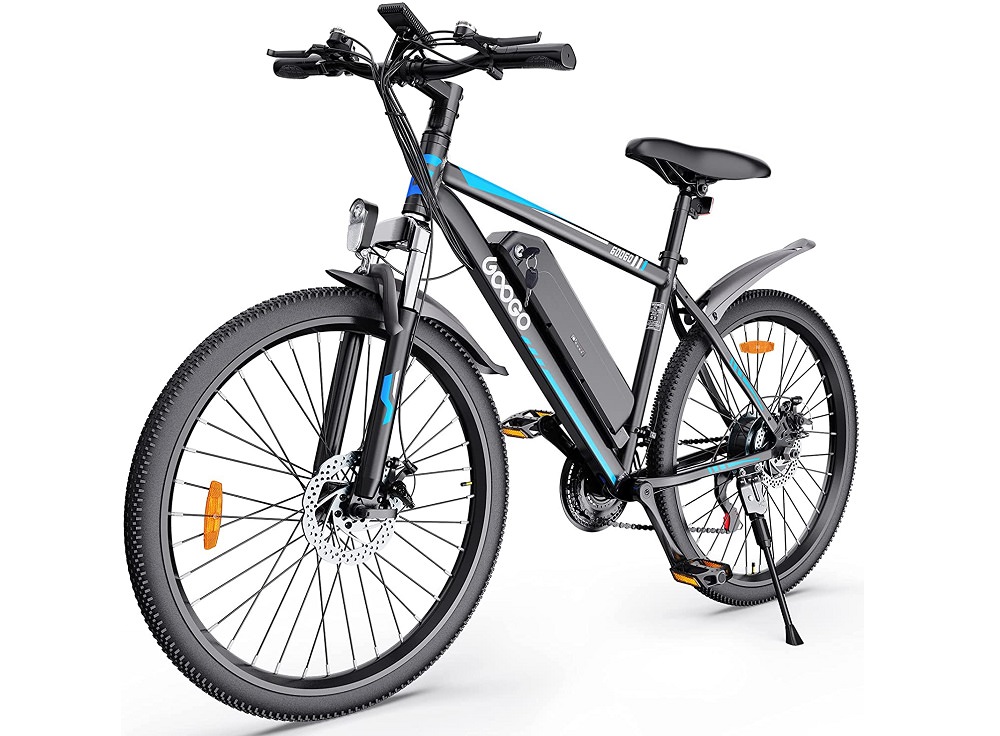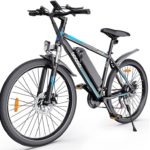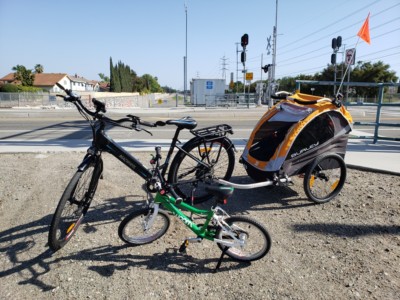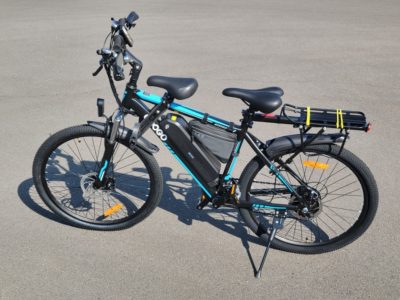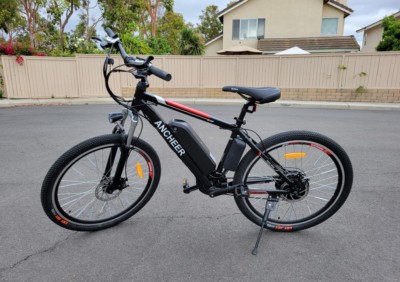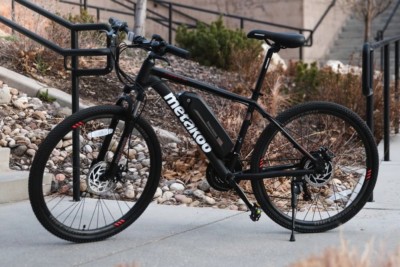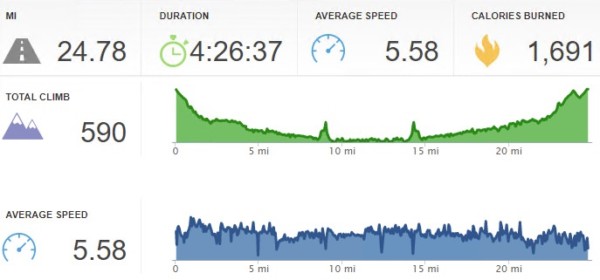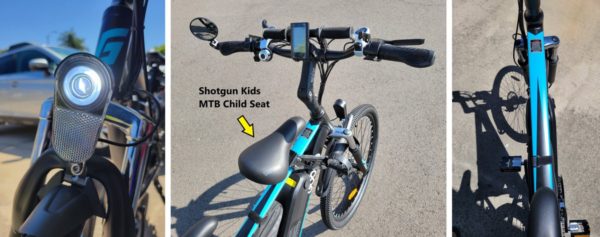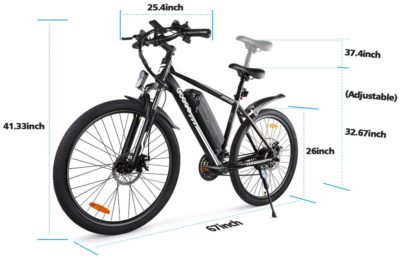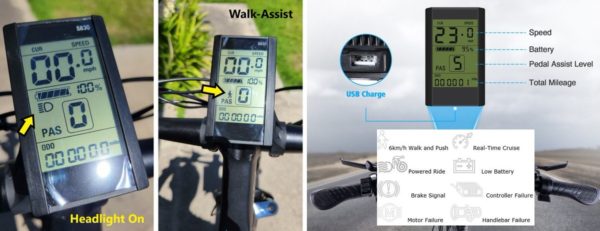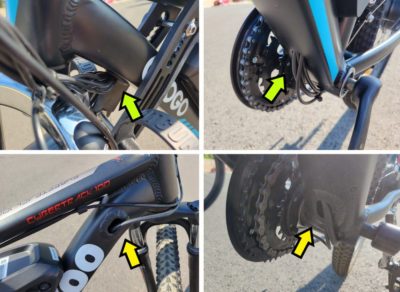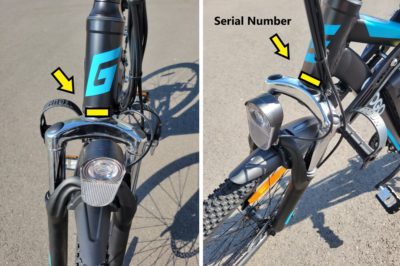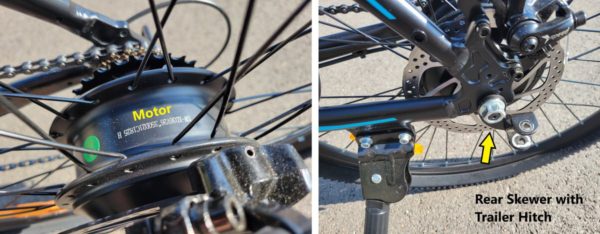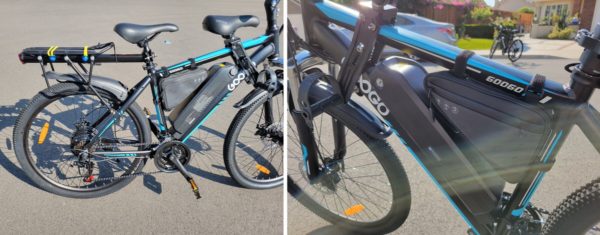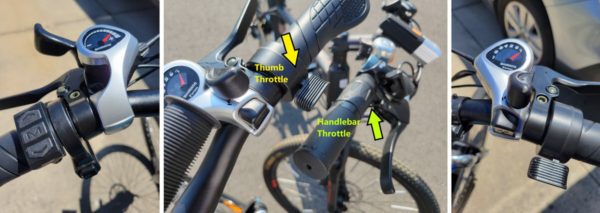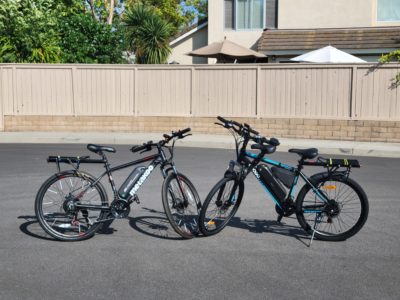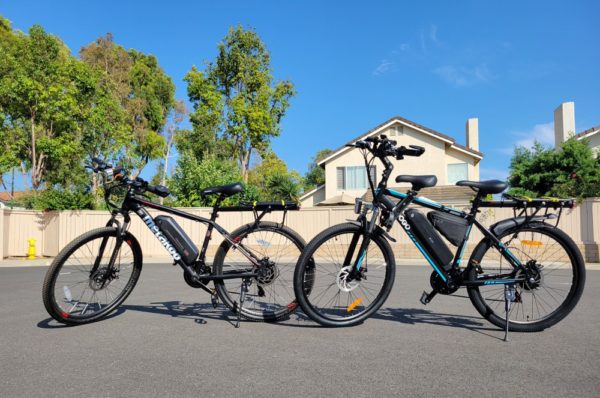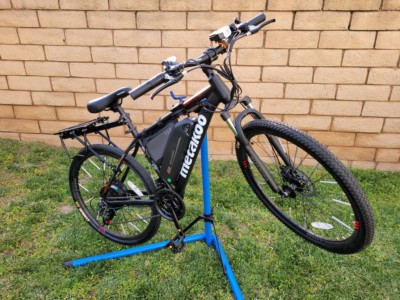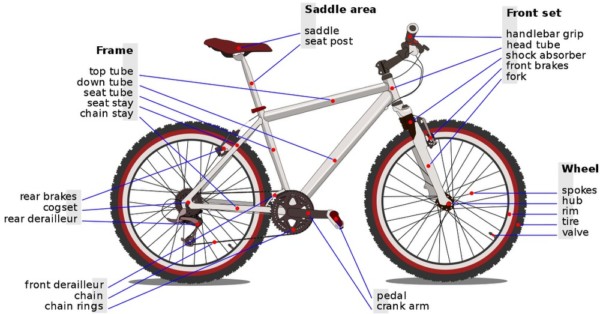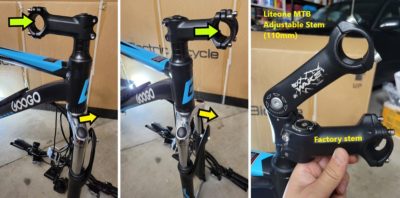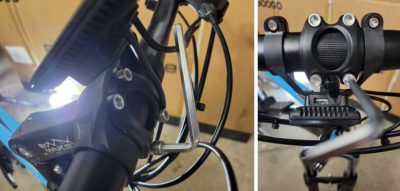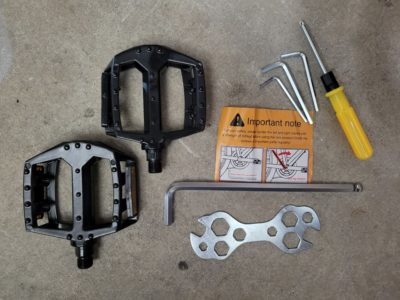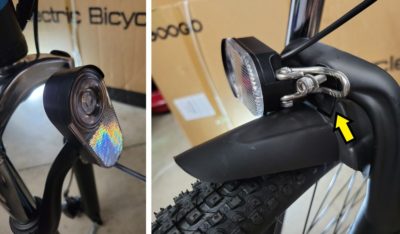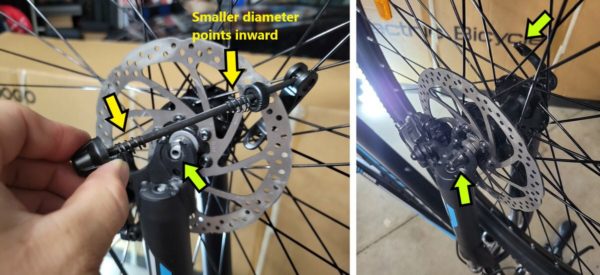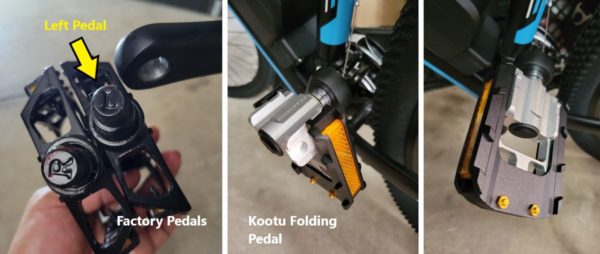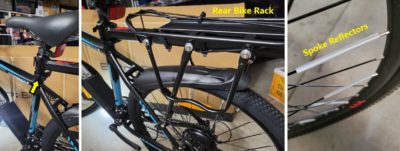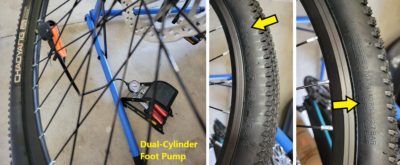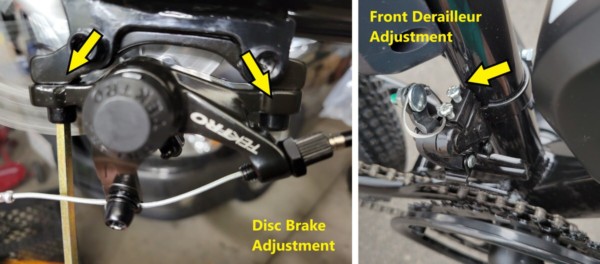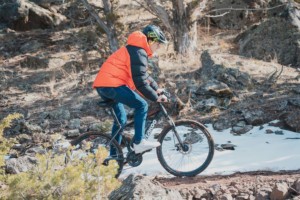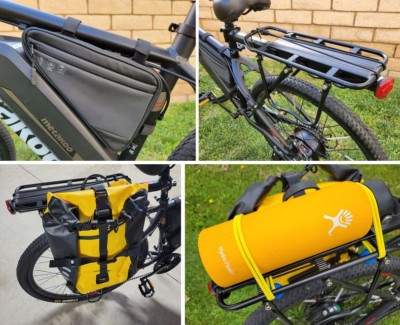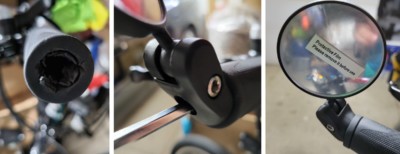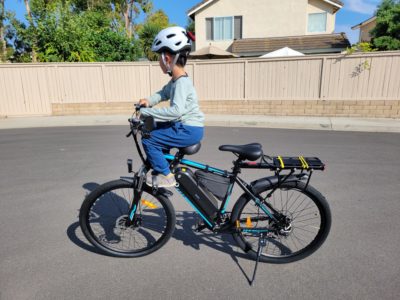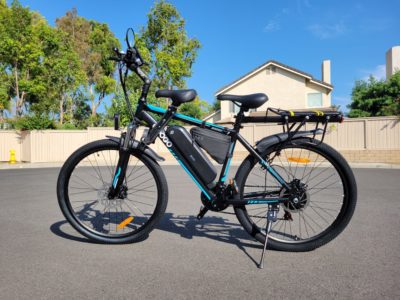Googo SY26 Electric Mountain Bike (26″, 21-Speed)
Pros
- Smooth, fast, silent acceleration
- Detachable, long-range 360Wh battery with lock
- Decent 350W motor with 5-level PAS
- Electronic horn, headlight with large LCD, USB port
- Shimano, 21-speed gears
Cons
- Some assembly required
- Throttle disabled when PAS is 0 (Off)
- Not for advanced mountain biking
- Quite heavy at 55 lbs
- Limited accessory mounting options
Contents
Well-Rounded Electric Bike
The Metakoo Cybertrack 100 electric mountain bicycle was my overall favorite, and sadly, it had not been available for sale on Amazon in recent weeks. I wanted to purchase another one for my dad as one of his upcoming retirement gifts, and so I went on the lookout for a similar one. The Googo Electric Mountain Bike (SY26 Blue) looked very promising after my brother’s Ancheer did not quite win me over from the Metakoo.
Why An eBike?
Electric bicycles have enabled our family to travel longer distances and visit more places even though many riders still shun them, my youngest brother included. They feel that motor assistance is cheating and I agree! Biking is as much a sport as it is recreational: on one hand, there are those who want to challenge their physical abilities, and on the other, it is a more leisure way to explore and bond with family and friends. Two children have steered the competitive me towards the latter as seeing the joy on their faces has even trumped the thrill I used to seek on the mountain trails.
The below is what I normally look for in a battery-powered bicycle. We will go over the reasons why later.
- Decent motor to aid with steep inclines
- 21 speeds/gears for tackling difficult, uphill climbs
- Pedal Assist System (PAS)
- Rides and looks like a normal mountain bike
- Detachable, large battery for long rides and convenient charging
The Googo SY26 is the 5th electric bike I have tested and reviewed. It has addressed some of the dislikes of my Metakoo Cybertrack 100 and brother’s Ancheer AM001907.
Bike or Scooter?
Electric scooters are more nimble to move around with — and in some cases, more fun — but local laws may prevent them from going onto the same paths as electric bicycles. Most can also be carried around more easily due to their more compact size and lighter weight. Personally, I prefer bikes because they are safer to operate, can (usually) go onto the same places that mechanical bicycles can operate, are (generally) allowed to carry an additional passenger, and if the battery runs out or fails, you can still pedal around. A scooter would stop to function without a battery.
In A Nutshell
Googo’s 26″ Electric Mountain Bike (SY26 Blue) should not be considered to be in the same league as my old, trusty Santa Cruz for hardcore, downhill rides on steep, rocky hills where a reliable, sturdy frame can make a huge difference. Where it does make sense, however, is how it compares to two similar bikes: Metakoo Cybertrack 100 and the awkwardly named Ancheer AM001907/AN-EB001. All three were available for about $700 and just 1/10th of a brand-new, non-motorized Santa Cruz Heckler.
My brother had loved the power and acceleration of Ancheer’s motor whose 500W of (nominal) power held a 43% advantage over both the Metakoo and Googo’s 350W. However, Ancheer’s very sudden rapid speed increase often felt almost a bit out of control at times and elevated my heart rate enough to question whether it was safe to tow my young children in their bike trailer. Metakoo’s cleaner look, smooth acceleration, build quality, on-demand power assist (PAS), battery fast-charge, and LCD screen tipped my preference towards it as I primarily pedaled manually and only engaged the motor for climbs with kids in tow. The Metakoo’s rear wheel skewer was also long enough to mount on a component for connecting a bike trailer, something the Ancheer lacked and would have required lots of labor to replace. However, where the Ancheer lacked was partially made up with the inclusion of a larger battery (450 vs 360-370 Wh) and an electric horn and headlight for evening rides. Then came the Googo SY26.
Googo’s bicycle had struck a great middle ground between the Metakoo and Ancheer and thus became my new, overall best pick for an electric mountain bike — though barely. Its good build quality, albeit not quite as solid as Metakoo’s, was better than Ancheer’s, had smooth acceleration, a large LCD screen with far more viewable information (and hidden USB charging port), electric horn and headlight, and the most generous clearance between the top and down tubes and behind the seat post. It was also able to accommodate hooking up our bike trailer right out of the box. I was happy to see that it only used about 25% of its battery on a 27-mile ride where the motor only assisted with towing 45-100 lbs* on climbs, putting it on par with the Metakoo.
The Pedal Assist System (PAS) is useful for when you want to pedal with a small amount of electronic help. The less the motor is engaged, the greater range and battery life (and exercise) you will have during the ride.
All three bikes had much in common. They were almost fully pre-assembled, fairly easy to put together even for the first-time installer, only required tuning the front disc brake and brake handle, and sometimes the front derailleur. YouTube was my best friend for finding answers to any issues I came across. The Googo only needed adjusting the front disc brake and cable — everything else was already factory-tuned. All had 21 Shimano gears for easier riding, 3 or 5 PAS levels, a brushless motor, removable Lithium-ion battery with key lock, 26″ tires, water resistance to rain, dual disc brakes, and looked like regular mountain bikes. Range was also similar with 25 miles on fully-electric and 40-55 mi with PAS modes, although I estimated 105 mi if pedaling manually with PAS only used for short climbs. The more you pedal (even along with the motor), the greater distance you could achieve. They had a fork (front) shock suspension for a smoother experience over bumpy trails and roads, maxed at 20 mph, and could accommodate riders between 5’3″ – 6’5″ tall and up to 330 lbs. Googo’s top speed could be unlocked to 26 mph, but keep in mind that going this fast may be illegal in your State or country and potentially wear down the motor prematurely.
Googo’s 55 lb weight had put it on the heavier side between the three bikes (compared to 50 and 46 lbs), but stood out with a 2 year warranty and a large, sunlight-readable, backlit 3.5″ LCD with detailed trip information. A USB port was also hidden underneath to charge a phone with, and as stated before, the Googo provided the most space between the top and down tubes as well as behind the seat post to allow accessories to be mounted. I liked the refined look and build quality of the Metakoo over the Ancheer, but the large, exposed hole on the side of its down tube gave me long-term concerns about rust and structural integrity caused by moisture or dust. The Googo, on the other hand, did not share that concern. I also liked its color scheme the most.
The only negatives I had with the Googo were its lack of battery fast-charging and on-demand power assist offered by the Metakoo. First, the detachable 360Wh battery could not be charged from empty in as quick as 3 hours as the Metakoo. It took 4.5-6 hours with its included 84W wall charger. Your use case may differ, but for our family’s needs that timeframe had been acceptable.
Second, I prefer to pedal manually and ONLY turn on motorized help for uphill climbs if I had heavy loads to tow (like children in a bike trailer). What I loved about the Metakoo was the ability to momentarily throttle on the motor on-demand while Pedal Assist (PAS) was off. Neither the Googo nor the Ancheer had that function: they both required PAS to be set to at least level 1 and that meant the motor would activate with pedaling. The workaround would be to keep PAS off (level 0) for manual pedaling, change to level 1 for assist, then back to 0 once over the hill. I would have preferred to just turn the throttle for assistance whenever needed without having to change PAS levels. That was not a deal-breaker, but something to be noted. Some riders may like Googo’s thumb throttle whereas I preferred the handle style that both Metakoo and Ancheer have.
The Googo’s top speed was 20 mph, but could be programmatically unlocked to 26 mph. Keep in mind that going this fast may be illegal in your State or country. See Programming section.
So, which bike was better? That was a really difficult decision to make and ultimately came down to preference. My brother loved the power and acceleration of the Ancheer, but the rapid speed increase often felt a bit unsafe for towing my young children in their bike trailer. Metakoo had fit my needs better overall at the time with its cleaner look, smooth acceleration, LCD speedometer, and on-demand motor assist while PAS was off. Then the Googo addressed all the issues I had with the other two bikes, but lacked the ability to activate the motor on-demand with PAS turned off at level 0, came with a thumb throttle instead of a handle one, and no fast-charging battery — minor but notable gripes.
The overall best bike for me was the Googo followed VERY closely by the Metakoo. Both were also able to accommodate the Shotgun Kids MTB Child Seat for when one of my kids wanted to ride up front. You could always retrofit an existing bicycle with an eBike kit, but Googo’s offering was a nicely streamlined package that looked and rode like a normal, recreational mountain bike with motorized assistance. We certainly had been grateful as parents for the pedal assist that had enabled us to ride longer distances with children and heavy weights in tow.
What’s Good? What’s Bad?
Pros
- Smooth, fast, silent acceleration with Xiongda brushless motor
- Nominal (average) power: 350W. Rated (maximum) power: 560W
- Metakoo: 350W (500W peak) / Ancheer: 500W (700W peak)
- Top speed: 20 mph, tested (California speed limit is 20 mph)
- Could be unlocked to 26 mph (see Programming section), but keep in mind that overheating the motor will cut its life short. Going that fast may also be illegal in your State or country
- Nominal (average) power: 350W. Rated (maximum) power: 560W
- (4) Power modes
- Fully electric: No pedaling necessary
- PAS – Pedal Assist System: Get assistance while pedaling
- Motor off: Move bike with the power of your own legs ;-)
- On demand: Turn thumb throttle to manually increase speed and motor assist level
- Battery: 360Wh Li-Ion (36V @ 10Ah)
- Cells made by Zhuonang, according to Googo customer service, although I believed they were INR18650 LiNiMnCoO2 by Hailong
- Detachable with Lock and 2 keys for more convenient charging
- Only used 25% over 27 miles with 45-100 lbs* in tow (plus my own body weight of 190 lbs)
- Motor was only activated to assist with uphill climbs, and the rest of the time was pedaled manually
- These types of batteries have a 500+ cycle lifespan and lose about 20-25% capacity after every 500 cycle
- Automatic power off (10 mins idle by default)
- Covered On/Off switch at front
- Waterproof
- Three color choices: Blue | Red | White
- Pleasant color scheme (Blue one was my favorite)
- Range: 25+ mi on fully-electric, 40+ mi on pedal assist modes (according to manufacturer)
- Estimate is in line with other 350W eBikes that have a 360-375 Wh battery
- Approx. 105 mi with occasional pedal assist based on my 27 mi ride with motorized help only on uphill climbs (while towing 190 lb rider, 45-100 lbs* cargo, and 55 lb bike itself)
- 84W wall charger (2A @ 42V)
- Manufacturer claimed empty to 100% in 5-6 hours. My tests ranged between 4.5-6 hours
- IPX4 water resistance – “Resistant to water splashes from any direction”
- Bikeable in rain but do NOT go through water that is high enough to reach the motor or battery!
- Shimano 21 speeds (3 front, 7 rear)
- When the battery is out, the higher number of gears will allow easier, more effective, manual pedaling
- Dual, mechanical disc brakes for faster, more controlled stopping
- Front shock suspension for smoother, comfortable handling, although there is no rear shock absorber
- Large 3.5″ LCD Control Panel (Model: S830)
- Displays speed (mph by default) / battery level / motor assistance amount (PAS 0-5) / odometer / trip distance and time / battery voltage / current, max, and average speed / headlight and brake indicator
- When motor assistance level is set to 0, motor does not turn on, and you will pedal fully manual
- Covered USB port underneath the display for charging devices
- Backlit with 3 intensity options and readable in bright daylight
- Some programmable settings. See Programming section
- Displays speed (mph by default) / battery level / motor assistance amount (PAS 0-5) / odometer / trip distance and time / battery voltage / current, max, and average speed / headlight and brake indicator
Serial number is etched into the lower, front part of the stem tube for registration with local police to aid with recovery
- Arrived nearly fully assembled
- Should take 15-20 mins to finish build, but took me significantly longer due to taking photos and making modifications with third-party additions and parts
- Rotate threadless stem, attach handlebar, pedals, front wheel, seat post, headlight, front/rear mud guards, and make small, tuning adjustments to the front brake
- Surprisingly, the Front Derailleur needed no adjustment, but the front disc brake and cable did (as expected)
- Should take 15-20 mins to finish build, but took me significantly longer due to taking photos and making modifications with third-party additions and parts
- Electronic headlight and horn
- Aluminum alloy frame with rider support for up to 330 lbs
- Can accommodate 5’3″ – 6’5″ biker height with its quick-release seat post
- Generous clearance between the top and down tubes and behind the seat post (when compared to the Metakoo/Ancheer)
- Streamlined cabling through the down tube
- Motor controller also housed inside like the Metakoo for a cleaner, better-protected look
- 26″ Tires (26 x 1.95 tube) for more controlled, comfortable rides
- Uses Schrader valve with recommended pressure of 40-65 psi
- Weight: 55 lbs, heavier than both Metakoo/Ancheer and a non-electric Santa Cruz Heckler
- Built-in kickstand
- Rear skewer long enough for mounting Burley trailer hitch
- Illustrated installation manual included
- Tools included
- 2 year warranty (googous.com) with registration
Cons
- No on-demand pedal assist while PAS is off (set to level 0). Minor gripe but would have been a nice-to-have
- Ancheer was the same way. Only Metakoo’s Cybertrack 100 had the option to temporarily kick on the motor by turning the handlebar throttle
- LCD screen may get damaged from a fall
- Electric Horn and Headlight do not work without turning on the LCD
- No electronic Taillight
- Extra battery can only be purchased by contacting Googo at googous.com for about $300 shipped (according to customer service)
- Although Googo said the battery was made by Zhuonang, the sticker found on my battery stated “INR18650” with “Model: HL”
- Searching for “HL INR18650” led me to Hailong, and so I believe that a 360 Wh (36V @ 10Ah) replacement made by Hailong for a 350W motor may work with the right connector
- Although Googo said the battery was made by Zhuonang, the sticker found on my battery stated “INR18650” with “Model: HL”
- No fast-charging of battery
- Metakoo included a 168W wall charger (4A @ 42V) that allowed its battery to go from empty to 100% in as little as 3 hours. Googo’s 84W charger took 4.5-6 hours
- Some may prefer a handlebar throttle instead of the thumb throttle
- Keys to lock/unlock battery were not numbered
- Keys may be generic/not unique, allowing someone with similar keys to unlock and steal the battery
- Some assembly required
- Those not well-versed with bike building may struggle a bit, especially if some tuning needs to be performed. I was able to obtain a video from Googo customer service and posted it on YouTube with their permission
- Illustrated manual was a bit lacking, but good enough to follow along for the more experienced installer
- Although written in English, it referenced some Chinese regulations
- Not built for advanced mountain biking
- Rear does not have shock suspension
- Heavy at 55 lbs
- Top tube may be too thick for child seats made for traditional bikes
- Shotgun Kids MTB Child Seat can expand to fit nearly any frame thickness
- LCD Control Panel had most of its Programming locked
Tips
Maintenance
- Before first use, charge the battery fully
- Covered charging port is on the removable battery itself
- AC charging brick LED: Red = Charging. Green = Full
- Lithium Ion batteries are known to be volatile and could catch on fire
- Do not charge overnight or unsupervised for prolonged periods of time. Stop charging once full
- Do not leave the bike in full sun or below freezing
- Keep battery charged at 50% or more to prolong battery’s 500+ cycle lifespan. Try to never let it drain completely
- Lithium-Ion batteries lose about 20-25% of capacity after every 500 charging cycle
- Before riding, check the tire pressure (40-65 psi) and tighten any loose screws
- Ensure seat post is locked and tight
Operations
- Motor: Switch battery on and turn on display by long-pressing the “M” button on the controller
- Pedal the bike, and you will feel the motor assisting (Pedal assist)
- Throttle the thumb accelerator by the right-side handle, and the motor will fully take over (Power on demand)
- The more you turn, the faster the bike will go
- To power off the motor so you would only be able to pedal manually, press “M” (Pedal only), set PAS to level 0 on the display, or turn off the battery
- Headlight: Turn display on, then long-press “Up” button
- Electronic Horn: Only available when display is turned on
- Data display: “M” button toggles Odometer, Trip mileage, Current voltage, Operating Current, Trip time
- Speed display: Long-press “Up” and “M” buttons to toggle Current, Maximum, Average speed
- Display backlight: Only turns on with the headlight
- Manual power assist: Press and hold “-” button for 2 secs to activate motor at low speed
- Helps with walking the bike uphill at 3.7 mph (6 km/h)
- When in motion, this activates low-speed cruise control
- As battery neared empty, I noticed that maximum speed gradually lowered
- Do not brake hard. Doing so could make you painfully tumble, skid, and/or wear out the tires
- Be aware of unexpected obstacles. I tumbled once while mountain biking and was hurt quite badly. It was not fun
Aircraft Transport
Most, if not all, airlines prohibit electronic scooters and bikes that do not meet specific criteria. United Airlines, for example, allows collapsible ones whose battery is both removable and below 300 Wh. Southwest Airlines is more restrictive at 160 Wh. This bike’s battery is 360 Wh. Lithium-ion batteries are known to be volatile, and the higher their capacity, the more risky they are. Check with the airlines, TSA, and FAA for more details.
Bike Assembly
Here are some installation tips for those assembling their first bicycle. First, look at the below diagram to identify the major bike parts, then watch the Googo-made YouTube video found right after.
Bike Repair Stands
I use a repair stand to help with assembly and maintenance. SereneLife SLBKRS3 has a maximum load capacity of 66.7 lbs — enough to carry most electric bikes without falling over.
For easier maintenance or assembly, a bike repair stand can save a lot of time and back pain. Be sure to get one that can hold up your bicycle’s weight.
Bike Parts
Installation Video
Step-By-Step
Note: Some third-party parts were replaced or added while I assembled the bike. I will point out which ones were not included by Googo.
Have included tools ready. Remove all protective material.
Attach stem (pointed forward), clamp the handlebar, and secure the headlight/front mud guard. Pay attention to the front fork: it faces forward. Screw the headlight and front mud guard onto it. The handlebar should be secured with the 4 bolts in alternating, opposite order. It is very important the bolts are securely tightened to prevent handles from coming loose while riding.
The factory stem was replaced with a Liteone MTB Adjustable Stem (110mm) so it was more raised and could be rotated to any angle within 90 degrees. This allowed my son to have a more comfortable, safer grip while sitting Shotgun.
Place Quick Release skewer through front wheel. There is a spring on each end with the narrow part facing inward toward the bike. Fasten wheel to the front fork. The arrows on the disc brake should be pointing in the same direction as the ones found on the side of the tire.
Attach pedals to the crank arms. Note the “L” and “R” label on each, respective pedal and use a wrench to securely mount them in the appropriate direction to the crank arms.
The factory ones were replaced with Kootu Folding Pedals to help save space while in storage.
Check rear derailleur protector. You may have to pull the protector a bit until it hovers nicely over the derailleur. It should be cleared enough for the derailleur to freely switch gears.
Install seat post and saddle, then inflate tires. Tires are sized 26 x 1.95 (26″), use Schrader valves, and should be inflated to 40-65 psi. I added a rear bike rack to carry cargo and spoke reflectors for additional safety. Esuik Dual-Cylinder Foot Pump was used to inflate the tires.
Attach the tail reflector and mud guard, adjust the seat post to the proper height (legs should be slightly bent at a 160 degree angle while seated and with foot on pedal at its lowest position), and do not lift the seat post beyond its maximum height line. Finally, fine tune disc brakes, brake handles, and gear shifters as needed.
Programming
To enter programming mode: Hold the “Up” and “Down” buttons for a few seconds until “P0 1” shows on the LCD. Cycle through the options with the “M” button, change values with “Up” or “Down”, and save the changed setting(s) by leaving the screen for a few seconds or long-pressing “M”.
Program Options
PROGRAM AT YOUR OWN RISK! Improper use may void warranty and/or cause bike to fail or be damaged.
Options marked with * were locked and could not be changed on my Googo.
- P01: Backlight brightness. 1-3 (brightest). Default: 2
- P02: Unit display. 0 = kilometers (km/h), 1 = miles (mph). Default: 1
- P03*: Battery Voltage. 24, 36, 48. Default: 36
- P04*: Idle time to enter sleep mode. 0-60 minutes. 0 = Do not sleep. Default: 10
- P05*: Power Assist (PAS) Mode. Default: 0 05
- First number (0 or 1): How many gears PAS will operate in
- 0 = 3 gears | 1 = 5 gears
- Second number: How much electric assistance is provided at each gear
- 3 gears | Gear 1 @ 2V assistance / Gear 2 @ 3V / Gear 3 @ 4V
- 5 gears | Gear 1 @ 2V assistance / Gear 2 @ 2.5V / Gear 3 @ 3V / Gear 4 @ 3.5V / Gear 5 @ 4V
- I am confused about this setting because the default is “0 05”. The first number indicates 3 gears, but I do not understand why the 2nd number is “05” instead of “03” gears
- First number (0 or 1): How many gears PAS will operate in
- P06*: Wheel diameter (inches) in 0.1 increments. Must match wheel size. Default: 26.0
- P07*: Number of magnets for measuring speed. 1-100. Default: 1
- P08: Maximum speed. 0-50 km/h. 50 or higher = No limit. Default: 32 (19.88 mph)
- Be sure to convert correctly as the unit is in km/h, not mph
- Changing limit to 50 or even 100 will allow the motor to run at its full capacity
- Can result in overheating and cut motor’s life short. Going over 20 mph may be illegal in your State or country
Warning: Configuring maximum speed to go past 20 mph can overheat the motor and cut its life short. Going that fast may also be illegal in your State or country.
- P09*: Motor startup. 0 = Can start without movement, 1 = Can only start when bike is moving. Default: 0
- P10*: Drive mode. 0-2. Default: 2
- 0 = Power Assist: Only PAS can control motor. Thumb throttle is disabled
- 1 = Throttle: Only Thumb throttle can control motor. PAS is disabled
- 2 = Power Assist + Throttle: Both PAS and Thumb throttle can control motor. Thumb throttle will not function when bike is stationary
- P11*: PAS sensitivity. 1-24. 1 = Most sensitive. Default: 2
- P12*: PAS start intensity. 0-5. 0 = less starting assistance. Default: 3
- P13*: Number of pieces per PAS magnet. 5, 8, 12. Default: 5
- P14*: Current limit. 1-20A. Default: 12A
- Ensure this is set to what the controller and hub motor can handle
- P15*: Unknown. Default: 30.0
- P16*: Odometer reset
- Long-press “Up” button to reset the odometer
Warning: Configuring maximum speed to go past 20 mph can overheat the motor and cut its life short. Going that fast may also be illegal in your State or country.
Motor Bike Laws
I first learned about laws governing motorized scooters when reviewing the Joyor X5S, and unfortunately, they were (and still are) not straight-forward. There had been a number of accidents involving scooters hitting pedestrians or riders hurting themselves. I get it. Laws are there to protect people from each other and themselves, especially from irresponsible individuals.
Electric bikes can result in severe injuries or death with their high speeds.
Surprisingly, the laws governing electric BIKES are much more lax. They are very similar to non-motorized bikes, in fact! There are different classes of eBikes. This Googo falls under the lower-speed Class 2 with a maximum of up to 20 mph, and as such, can be used on Class 1 bike paths in California. All 3 classes can ride on the protected, one-way Class 2 bike lanes found on streets and highways. Be sure to check with your local regulations. Some States categorize eBikes as mopeds or motor vehicles.
- Class 1: PAS-only with no throttle. Max assisted speed: 20 mph
- Class 2: PAS and throttle. Max assisted speed: 20 mph
- Class 3: PAS-only with no throttle. Max assisted speed: 28 mph
California Law
Disclaimer: I AM NOT A LAWYER. Please consult your local city, police department, and/or legal professional for advice.
The following is my interpretation of how I understand the law. It has been shortened to only point out parts that I found interesting or noteworthy.
- Does NOT require riding with a Driver’s License or Instruction Permit (eScooters require them!)
- No license plate required
- Passengers are allowed as long as the bike was designed for it
- Can ride on existing bike infrastructure
- Speed limited to 20 mph
- Follow most of the same laws as non-motorized bicycles
- Helmet required for riders 17 years and younger
- No minimum age limit
Accessories
Some accessories I recommend for this bike for added convenience and safety:
- Yttao (Triangle) Bike Storage Bag: Holds mini tire pump, replacement tubes, and bike repair tools
- Rear Bike Rack: Enex, Dirza, or Vincita – For use as a luggage carrier or seat for a second person
- Rhinowalk Pannier Cargo Bag: A 27L, waterproof, very visible bike, laptop, and shoulder bag for a bike rack
- Ball Bungees: To fasten cargo more securely to the rack, such as my favorite Hydro Flask water bottles that can hold ice for days
- Salzmann 3M Spoke Reflectors: For increased visibility in the dark
- Bar End Bike Mirrors (like BriskMore, Tagvo, or Zacro): To see behind you
- Liteone MTB Adjustable Stem (110mm): To angle handlebar at a desired height and angle
- Kootu Folding Pedals: To take up less storage space and not get snagged on things
- Burley Trailer Coupler: So trailer can be switched to another bike (ie. bike failed or ran out of battery)
Kids Bike Seats
See my Shotgun Kids MTB Seat (Review) and why I chose it over trailers, tow bars, and rear seats for quick, short rides. It has become one of my favorite additions for providing front-seat thrills to my kids.
Final Thoughts
The Googo SY26 had been a fun, recreational mountain bike to ride that did not feel any different from a mechanical one. It slightly edged out my previous favorite, the Metakoo Cybertrack 100, by striking a great balance in design, features, and performance, and thus became my new, overall best pick. It achieved the advantage with a large, informative, programmable LCD screen with USB charging port, better cable routing and resulting clearance between the top and down tubes, pleasant color scheme, and battery-powered horn and headlight.
Its fast-accelerating motor provided enough power to assist me pedaling up hills (with 45-100 lbs* in tow over a 27-mile stretch), and for that I was very thankful. Without electrical assistance, my thighs would have cramped much earlier and made for a very painful ride back home — and perhaps both young children crying about why it took so long to get back.
I very much appreciated the ability to remove the battery for much easier charging at home or work without having to bring the entire bike inside. Additionally, the battery itself could be securely locked to the frame to minimize the risk of theft. Shifting between the 21 gears was seamless with Shimano derailleurs, and the disc brakes performed as expected for controlled stops.
My family and I had very much enjoyed exploring town together instead of idling around in the car. It is both a healthy activity and a great way to bond with one another while building up the children’s confidence and endurance. My parents will be ecstatic to soon bike with their grandchildren at retirement!
I have not found myself going back to a non-motorized bicycle for daily rides, although I would still only take out my trusty Santa Cruz for more advanced mountain thrills. Either way, it is good to have the option to dynamically turn on or off electronic pedal assist.
Footnotes
* Total 45-100 lbs weight towed on a 27-mile ride consisted of: (28 lbs) Burley D’Lite 2-Seat Bike Trailer/Stroller / (13 lbs) Woom 3 Kids Bike – See how I taught my son to ride / (41 lbs + 12 lbs) Son and daughter / Water and snacks
Where To Buy
- Googo SY26 e-Bike (Color: Blue / Red / White)
- Accessories
- Yttao Triangle Bike Storage Bag
- Rear Bike Rack: Enex, Dirza, or Vincita
- Ball Bungee Cords | Rhinowalk Pannier Cargo Bag
- Salzmann 3M Spoke Reflectors
- Bar End Bike Mirrors: BriskMore, Tagvo, Zacro
- Liteone MTB Adjustable Stem (110mm) | Kootu Folding Pedals
- Hydro Flask Insulated Water Bottles
- Burley D’Lite 2-Seat Bike Trailer/Stroller
- Additional Trailer Coupler so Burley can be switched to another bike (ie. bike failed or ran out of battery)
Related Posts
- Reviews
- HeyBike Cityrun: Beautiful, 26″ electric cruiser bike with 500W motor, 7 speeds (21mph)
- Polarna M4: 20″ foldable, electric bike with 750W motor, 8 speeds (30mph+), and 4″ fat tires
- Jasion EB7: 20″ foldable electric bike with 3″ fat tires, 7 speeds, and can accommodate 5’1″ – 6’2″ tall riders
- Metakoo Cybertrack 100: 26″ electric mountain bike with 21 speeds and a clean look
- Ancheer AM001907/AN-EB001: 26″ electric mountain bike with 21 speeds, electronic headlight and horn, and powerful, rapid acceleration
- Macwheel Ranger 500: Comfortable, 7-speed, electric cruiser for city commutes
- Gyroor C3: Single speed, electric, semi-foldable, and priced fairly low
- How to Quickly Teach a Child to Ride a Bike (Balance With No Training Wheels)
- Bike USA Stabilizer Wheels for Adult Bicycles

